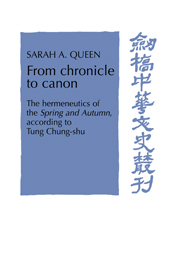Book contents
- Frontmatter
- Contents
- List of tables
- Acknowledgments
- List of abbreviations
- 1 Introduction
- PART I Three perspectives on the authenticity of the Ch'un-ch'iu fan-lu
- PART II Exegesis and canonization
- 5 The Spring and Autumn and Kung-yang tradition
- 6 Reforming the Ch'in laws
- 7 The wider circle of Han jurisprudence
- 8 Refashioning the imperial rites
- 9 Canon, cosmos, and court patronage
- 10 Conclusion
- Appendix 1 The birth and death dates of Tung Chung-shu
- Appendix 2 The dates of the Han-shu 56 memorials
- Appendix 3 Han transmission of Kung-yang learning
- Appendix 4 Han dynasty disciples of Tung Chung-shu
- Appendix 5 Citations and titles attributed to Tung Chung-shu
- Appendix 6 Transmission of Ch'un-ch'iu fan-lu editions
- Selected bibliography
- Index
5 - The Spring and Autumn and Kung-yang tradition
Published online by Cambridge University Press: 10 December 2009
- Frontmatter
- Contents
- List of tables
- Acknowledgments
- List of abbreviations
- 1 Introduction
- PART I Three perspectives on the authenticity of the Ch'un-ch'iu fan-lu
- PART II Exegesis and canonization
- 5 The Spring and Autumn and Kung-yang tradition
- 6 Reforming the Ch'in laws
- 7 The wider circle of Han jurisprudence
- 8 Refashioning the imperial rites
- 9 Canon, cosmos, and court patronage
- 10 Conclusion
- Appendix 1 The birth and death dates of Tung Chung-shu
- Appendix 2 The dates of the Han-shu 56 memorials
- Appendix 3 Han transmission of Kung-yang learning
- Appendix 4 Han dynasty disciples of Tung Chung-shu
- Appendix 5 Citations and titles attributed to Tung Chung-shu
- Appendix 6 Transmission of Ch'un-ch'iu fan-lu editions
- Selected bibliography
- Index
Summary
The Spring and Autumn became part of the Confucian canon in 136 b.c.e., when Emperor Wu limited the erudites to the Five Scriptures, one each for the Odes, the Documents, the Changes, the Rites, and the Spring and Autumn. In 124 b.c.e. the emperor established the Grand Academy (T'ai-hsüeh), where erudites expounded on these works to prepare students for government service. Emperor Ling (r. 168–189) ordered definitive editions of the Five Scriptures engraved in stone in 175 c.e., the final act in Han times symbolizing the establishment of the Confucian Canon. How did the Spring and Autumn come to enjoy canonical status under Emperor Wu? As I suggested in the Introduction, a variety of factors contributed to the text's rise to canonical status. Chief among them were Han scholars, like Tung Chung-shu, who reformulated its authoritative dimensions in terms relevant to the new circumstances of the Han empire and the reformist policies they hoped to institute. To understand Tung's contributions as one of the foremost Western Han exegetes and teachers of the Kung-yang Commentary to the Spring and Autumn, however, a brief introduction to the text and its pre-Han interpreters is in order.
Long before 136 b.c.e., master–disciple lineages had begun to transform the Spring and Autumn from a terse historical chronicle to a text embodying the highest ideals of the Confucian tradition. Five interpretive lineages are known to have arisen and passed on their beliefs through oral transmission: the Kung-yang, Ku-liang, Tso, Tsou, and Chia.
- Type
- Chapter
- Information
- From Chronicle to CanonThe Hermeneutics of the Spring and Autumn according to Tung Chung-shu, pp. 115 - 126Publisher: Cambridge University PressPrint publication year: 1996

